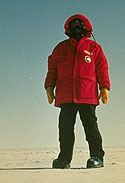
|

|
|
|
The
official NSF parka
©
NSF
|
|
|
|
 p.2
p.2
|

|
by
Paul Doherty
The
Pros of Polypropylene
Since the old days, it's been well known that wet wool keeps
people warmer than wet cotton. Cotton is a hydrophilic, or
water-loving, fiber; wool, on the other hand, has oils that
make it hydrophobic, keeping it from soaking up moisture.
Polypropylene (aka Polypro) is a synthetic fiber with water-resistant
characteristics like wool. Polypro maintains its insulating
value when wet and dries quickly. But its fibers can also
be used to weave clothing that is lighter and more compressible
than wool, while providing just as much insulation.
When
used in coats and pants, Polypro is called "fleece."
Fleece comes in different thicknesses, from the thinnest 100-weight,
to the heavier 200-weight, to the heaviest 300-weight fleece.
In Antarctica, I'll wear Polypro pants and a 200-Polypro jacket
under my down coat almost all the time when I'm outdoors.
Polypro
is especially effective as the innermost layer of insulation--long
underwear tops and bottoms. Early designs of Polypro underwear,
however, revealed its biggest problem: It absorbed oil from
the skin. After weeks of use, this human skin oil would become
rancid, imbuing the underwear with a strong, unpleasant odor.
Patagonia developed an improved Polypro fiber, called Capilene,
which did not absorb oils, remaining pleasant-smelling for
a longer time.
Polypro
also makes a good mitten liner. Mittens get damp when used
in the snow, so it's important to dry them out every night.
Depending on their thickness, your gloves can keep you warm,
but are also likely to reduce your dexterity.
Mitten
shells that block the wind and keep out water are made of
Goretex.
Holey
Goretex
Goretex is an impermeable layer pierced by extremely small
holes. These holes allow water-vapor molecules (and some air)
to pass through, but not water droplets.
Besides
being effective for blocking the wind (some down and Polypro
coats use inside layers of Goretex as windblocks), a raincoat
made of Goretex will "breathe," allowing humid air
from body sweat to leave.
We'll
use Goretex pants as our outermost layer, since they are excellent
for blocking the wind and keeping out water.
Beneficial
Bunny Boots
Named from a mistaken notion that rabbit fur was the insulation,
bunny boots have rubber inner and outer surfaces with insulating
material in between. Thick and well padded, these boots keep
your feet warm. However, they also keep your feet wet. Users
must take care to dry their feet every night, change into
fresh socks, and use foot powder to control fungus growth
and prevent infections. This useful footwear has been known
by other names as well, including Korea boots, K boots, and
mouse boots (after Mickey Mouse).
Bunny
boots are fine when the going is easy, but on rougher terrain
you can use "double boots." Made of a tough plastic
outer shell and an insulating inner liner, double boots have
soles that can be used to hike on snow or kick steps into
snowy ridges. They can also serve as a solid platform for
mounting steel crampons. These indispensable devices have
12 sharp points sticking out (10 on the bottom and 2 at the
toe), which can come in handy when walking on ice. Swing the
two front points into a vertical wall of ice and they'll penetrate
and stick, allowing you to "walk" up an ice wall.
Together,
these tools and materials will help keep us safe and comfortable
in the wilds of Antarctica. Watch our dispatches to see how
we put them to use!
|

